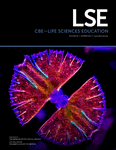Abstract
Large class learning is a reality that is not exclusive to the first-year experience at midsized, comprehensive universities; upper-year courses have similarly high enrollment, with many class sizes greater than 200 students. Research into the efficacy and deficiencies of large undergraduate classes has been ongoing for more than 100 years, with most research associating large classes with weak student engagement, decreased depth of learning, and ineffective interactions. This study used a multidimensional research approach to survey student and instructor perceptions of large biology classes and to characterize the courses offered by a department according to resources and course structure using a categorical principal components analysis. Both student and instructor survey results indicated that a large class begins around 240 students. Large classes were identified as impersonal and classified using extrinsic qualifiers; however, students did identify techniques that made the classes feel smaller. In addition to the qualitative survey, we also attempted to quantify courses by collecting data from course outlines and analyzed the data using categorical principal component analysis. The analysis maps institutional change in resource allocation and teaching structure from 2010 through 2014 and validates the use of categorical principal components analysis in educational research. We examine what perceptions and factors are involved in a large class that is perceived to feel small. Our analysis suggests that it is not the addition of resources or difference in the lecturing method, but it is the instructor that determines whether a large class can feel small.



